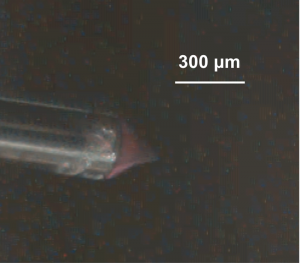Electrospray Nanoprinting on Electrospun Nanofiber Mats for Low-cost Biochemical Detection
- Category: MEMS & BioMEMS, Nanotechnology
- Tags: eric heubel, luis velasquez-garcia
An electrospray emitter ionizes polar liquids using high electrostatic fields. The electric field produces suction on the free surface (meniscus) of an electrically conductive liquid, and the surface tension of the liquid tends to counteract the effect of the electrostatic suction. If the electric field is larger than a certain threshold, the meniscus snaps into a conic shape called a Taylor cone [1] (see Figure 1). A Taylor cone emits charged particles from its apex due to the high electrostatic fields present there; these particles can be ions, droplets, fibers, etc., depending on the working liquid and the emitter flowrate [2] . In particular, electrospray in cone-jet mode [3] creates near-monodispersed charged droplets that can be used for many applications including mass spectrometry [4] , etching [5] , and nanosatellite propulsion [6] . In this project we are exploring electrospray in cone-jet mode as a technology to create controlled nanoimprints on electrospun nanofiber mats with liquids such as fluorescent dye and nanoparticles solutions, as an alternative technology to nano-pipetting or ink jet printing. Using a shadow mask, we have shown imprints in close agreement with the dimensions of the mask aperture (see Figure 2). The long-term goal of the project is to investigate the design space of the technology to make low-cost and low false-positive biochemical detectors by exploring the multiplexing and scaling-down limits of cone-jet mode electrospray sources using batch micro- and nanofabrication [7] .
- Figure 1: A Taylor cone at the end of a 300-μm OD capillary. Charged droplets are emitted from the apex of the cone. The working liquid is a fluorescent dye.
- Figure 2: Sub-millimeter electrospray imprints on an electrospun fiber mat using a slit.
- G. I. Taylor, “Disintegration of water drops in an electric field,” Proc. Royal Society of London A, 1964, vol. 280, pp. 383-397. [↩]
- J. Fernandez de la Mora, “The fluid dynamics of Taylor cones,” Ann. Rev. of Fluid Mec., vol. 39, pp. 217-243, 2007. [↩]
- J. Fernandez de la Mora, “The current emitted by highly conductive Taylor cones,” J. Fluid Mechanics, vol. 260, pp. 155-184, 1994. [↩]
- J. B. Fenn, M. Mann, C. K. Meng, S. F. Wong, and C. M. Whitehouse, “Electrospray ionization for mass spectrometry of large biomolecules,” Science, vol. 246, no. 4926, pp. 64-71, 1989. [↩]
- M. Gamero-Castaño and M. Mahadevan, “Sputtering of silicon by a beamlet of electrosprayed nanodroplets,” Appl. Surf. Sci., vol. 255, pp. 8556-8561, 2009. [↩]
- L. F. Velásquez-García, A. I. Akinwande, and M. Martinez-Sanchez, “A planar array of micro-fabricated electrospray emitters for thruster applications,” J. of Microelectromech. Sys., vol. 15, no. 5, pp. 1272-1280, 2006. [↩]
- B. Gassend, L. F. Velásquez-García, A. I. Akinwande, and M. Martinez-Sanchez, “A microfabricated planar electrospray array ionic liquid ion source with integrated extractor,” J. of Microelectromech. Sys., vol. 18, no. 3, pp. 679-694, 2009. [↩]

